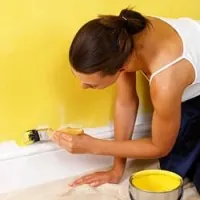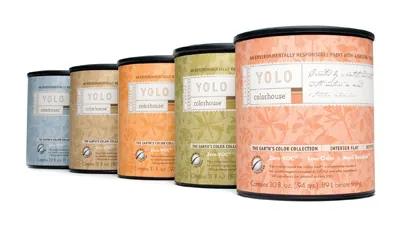Of all the chores that come with building a dream home, painting the walls is at the bottom of the popularity list.

Sure, most homeowners are eager to make a splash with their interior decorating, dreaming of something unique and inspiring. Then all of a sudden you are sifting through stacks of paint chips while hundreds of colors swirl before your eyes. You can no longer determine what color, what finish, nor which brand is best for any project. How do you make these decisions?
When taking on any paint project, determining what types of paint should be used in your home is the first and most important step. Your neighborhood hardware store should have representatives that can help you find just the right paints, but it is important to educate yourself on the basics:
Latex
Latex paint is water based and most typical of indoor applications. It is almost odorless, cleans up with soap and water, and dries quickly. Latex paints are also extremely resistant to yellowing with age.
-
Applications: Drywall, plaster, masonry walls, and most already painted surfaces.
-
Avoid: Raw wood or wallpaper as the water is absorbed and ruins surfaces.

Alkyd/Oil
Alkyd or oil based paint is more complicated to use than latex. Oil based paint is difficult to apply, dries slower, and cleanup requires paint thinner or other solvents. This makes it especially important to paint carefully and pay extra attention to proper ventilation. Oil based paint does have its positives. It goes on smoother and harder than latex paint, freeing walls from brush marks. It is also better at covering surface imperfections.
-
Applications: Wood, plywood, particleboard, hardboard, and any painted or wallpapered surface. Also good for glossy surfaces because of the firmer adhesion.
-
Avoid: Bare masonry, bare wallboard, and plaster.
Low VOC & Natural
Demand for Natural, Low- and Zero VOC paints has recently flooded the market. Volatile organic compounds (VOC) are low-level toxic emissions that contribute to indoor air pollution and can harm your health. Though once a necessity for quality performance paints, today's consumers are looking for a more eco-friendly approach to decorating their homes. While most homeowners look for safe, "non-toxic" interior paints, it is hard to determine just what is considered "non-toxic":
-
EPA standards require paints to have no more than 200 grams of VOC per liter.
-
Low VOC paints are those with 50 grams or less per liter.
-
Zero VOC paints have no more than 5 grams per liter.
-
Natural paints are made from natural ingredients and are the healthiest overall.
Keep this in mind when searching for your interior paints. As demand for more environmentally friendly products has increased, so has the realm of colors and finishes available in natural, low- and zero VOC paint.
-
Applications: Can be used like latex.
-
Precautions: Natural based paints have specific restrictions based on the ingredients. For example, milk based paints should not be used in rooms with high humidity. The extra moisture can generate a sour odor. Ask about restrictions before purchasing.
In addition to the different kinds of paints, there are numerous finishes to choose from. It is important to know what finishes should be used in various parts of your home to maximize coverage and durability.

Flat
A flat finish is great to use on large surfaces as it does not reflect light – the matte coverage discreetly hides minor imperfections that accumulate on interior walls. This finish is recommended for low traffic areas such as dining rooms, master bedrooms, and ceilings due to its lower durability. Some brands also carry specific ceiling flats that are spatter resistant, making ceiling application much simpler and efficient.
Eggshell/ Satin
Occasionally the terms "eggshell" or "satin" are used to describe a finish. These are quite similar to a flat finish, though slightly more durable with a little more sheen. The difference is often negligible, especially among varying brands.
Semi-gloss
The semi-gloss finish is ideal for high-traffic areas of the home such as the kitchen, bathrooms, doors, and children's rooms. It stands up well to high moisture content and is easiest to clean. This high durability finish is the most popular among homeowners.
Gloss/High-gloss
A gloss finish, also referred to as "high-gloss," is often used in small quantities to highlight details and trims. The most durable paint, gloss can withstand frequent cleaning. However, it is often avoided for large surfaces due to the amount of light it reflects.
Now that you are familiar with the type of paints and finishes available, it is time to browse the stores. Do not be overwhelmed by the many brands and colors filling the shelves at your local hardware store. Seek out a representative and explain what project you are undertaking. Ask for recommendations, shop around for cost-effective options, and take your time settling on a color.
Remember that the key to a successful paint job is flexibility and patience. Paints chosen often will not turn out exactly as you had in mind. However, by patiently applying samples, examining them under home light, and finding colors that truly fit your home and style, you will get your dream paint job.
Here are some related articles:
Save this article to:
back to top